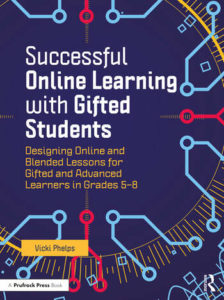Online Learning Tools for Gifted Middle Graders
Successful Online Learning with Gifted Students: Designing Online and Blended Lessons for Gifted and Advanced Learners in Grades 5-8
By Vicki Phelps
(Routledge/Prufrock Press, 2022 – Learn more)
Reviewed by Dr. Kevin D. Cordi
 What is the first step in teaching gifted middle school students, especially in an online environment?
What is the first step in teaching gifted middle school students, especially in an online environment?
In a 2016 blog series from the National Association for Gifted Children, the authors list the myths around teaching gifted adolescents. The first myth listed is “gifted students don’t need help; they’ll be fine on their own.”
They ask:
Would you send a star athlete to train for the Olympics without a coach? Gifted students need guidance from well-trained teachers who challenge and support them in order to fully develop their abilities.…The role of the teacher is crucial for spotting and nurturing talents in school. (Source)
 Gifted students need extended direction. Upon reading Successful Online Learning with Gifted Students (2022) by Vicki Phelps, I found my first inclination was to share that the lesson plans and activities in the book would work well with all students.
Gifted students need extended direction. Upon reading Successful Online Learning with Gifted Students (2022) by Vicki Phelps, I found my first inclination was to share that the lesson plans and activities in the book would work well with all students.
The lessons and ideas are creative and insightful. They are not commercially made lessons. Instead they require the student to think and respond in a way that develops advanced thinking. Is this not the goal of all learning?
Even though this is probably true, it would miss the objectives of the book – to help educators create lessons and develop ideas that help gifted students. Too often teachers simply provide gifted students with more of the same material, or, instead of helping them advance, teachers ask the gifted students to teach other students who are having difficulty.
This tendency might be because teachers rarely take classes that address working with gifted kids. I have talked with teachers who feel inadequate with these students. This book helps beginning and experienced educators explore new ways to reach “the gifted.”
There are many texts offering lesson plans, but few of them speak to designing plans to meet the needs of gifted students. In my classes I found some of the gifted students would report back they were bored or not challenged by the material. In observing teachers over the years, I have heard educators direct gifted students to ‘read the next chapter’ or do more problems in the back of the book. Designing plans meeting the needs of gifted students can be even harder when teaching online.
This book suggests we do more to help these students. As Phelps notes, “as educators, we should always be asking ‘why’ we teach what we teach (p. 3).” She also stresses that when working with gifted students online, a key to learning is motivation.
Online study for each type of gifted learner
Phelps first shares what a gifted learner might look like based on Neihart and Betts’ (2020) gifted profiles:
- historically underserved learner,
- autonomous learner,
- creative learner,
- successful learner, and
- twice-exceptional learner.
She offers suggestions to help each type of learner achieve in the online environment. This is a handy reference to help teachers recognize the varying needs and ways to motivate gifted learners.
She provides guiding questions to evaluate if students are learning, arguing that a key goal for students to respond to their work is to justify it. “This magic happens when gifted and advanced learners are not only engaging with the advanced concepts, but they are also actively engaged with justifying and explaining their synthesis of learning (p. 14).”
In my recent teaching of literacy classes for pre-service middle school teachers, I have found it is not enough for my future educators to read a text; instead we create and produce work in small groups, and they must justify the question, “How does what you create and produce extend deeper thinking and create resonance around the reading?”
At first, my students tried to justify the resonance for students with the Venn Diagram but failed to show the permanence with, for example, their book clubs. Soon they began to create jazzed up videos on YouTube that contained not only textual references but also arguments around the text.
One example: The book was set during the Chernobyl accident in Russia, and to create deeper impacts with the students, they showed the inaccuracy on the death count in the book and in newspapers. This also invited spirited conversations and connections around current events in Russia.
Tech tools for online study
Phelps states that when using online assignments, we need to differentiate the tools we use and justify why we are using them. We need to ask what purpose they serve.
She leans toward using Google tools. My school uses a Microsoft toolset, and I was hoping to see how that might fit with this system. However, Google tools are free, and any teacher can use them including Google Docs, Google Forms, and Google reminders. She also advocates tools such as Padlet and shares the way it interacts for students when asking questions.
Phelps also considers online meeting spaces such as Teams and Zoom. I was surprised to see Kahoot included. I recently became familiar with the 3E Framework by Liz Kolb which is an online system that assesses how useful a particular technology tool is and provides suggestions on how to use it. I assessed Kahoot on this, and it scored very low. You can find out more about this assessment here.
I would emphasize that Phelps’ book is not a hodge-podge of apps and tools, but instead shows how online tools can be used in purposeful ways; e.g., using Puzzle Party (p. 31) to help students learn to collaborate by working on an online puzzle together.
Taking escape rooms online
I was intrigued by the section on Escape Rooms. This is an online and in-class activity where students are supplied “clues” to solve, and until they are solved, students can’t move on.
Not long ago, I walked into a library where the librarian had created an escape room with new books by young adult authors. There were physical black boxes with locks that hid the book. All around the library posters gave clues on what was in the box, and questions inspired by the text moved one closer to opening the locked box. It was energetic and invited the “chaos of discovery.” You could hear the excitement as students clamored for the next clue.
Phelps suggests that this type of excitement can be generated online and mentioned applications such as Flippity.net that help students create the room. She also includes sites that already have the rooms designed.
In addition to escape rooms, Phelps discusses how creating simulations can also provide rich experiences for gifted students. She provides a Space simulation in the text that invites involvement and encourages students to work together in the simulation.
Leading with the how and the what
At a time when we are sometimes struggling to learn online applications, Phelps reminds us that, when working with gifted students, instead of starting with instructions on how to use the tools, ask why are we using them. Do they serve to keep the students engaged? What are the outcomes after the students use this technology, and what are they using it for?
Successful Online Learning with Gifted Students is an informative text that reminds us that when teaching gifted students with online tools, the why and the how are often more important than the what. I know it has me thinking about new ways of differentiating my lessons and finding new ways students can justify what they learn.
My future students will be rewarded by the reflection and ideas in this book.
Dr. Kevin D. Cordi serves as an Assistant Professor of Education and Middle Childhood Coordinator of Education and Literacy at Ohio University Lancaster. He is also a national/international professional storyteller and coach of storytellers. He has written books on the art of storytelling, most recently You Don’t Know Jack: A Storyteller Goes to School (University of Mississippi Press, 2019). He currently hosts a monthly Livestream called Debut: A Fusion of Storytelling and Play. Find out more about his work at www.kevincordi.com.


































